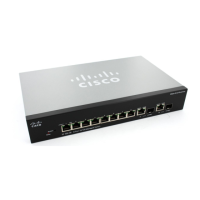Configuring IP Information
Management and IP Interfaces
Cisco Small Business 300 Series Managed Switch Administration Guide 168
15
Managing IPv6
The Internet Protocol version 6 (IPv6) is a network-layer protocol for packet-
switched internetworks. IPv6 was designed to replace IPv4, the predominantly
deployed Internet protocol.
IPv6 introduces greater flexibility in assigning IP addresses because the address
size increases from 32-bit to 128-bit addresses. IPv6 addresses are written as
eight groups of four hexadecimal digits, for example
FE80:0000:0000:0000:0000:9C00:876A:130B. The abbreviated form, in which a
group of zeroes can be left out, and replaced with '::', is also acceptable, for
example, ::-FE80::9C00:876A:130B.
IPv6 nodes require an intermediary mapping mechanism to communicate with
other IPv6 nodes over an IPv4-only network. This mechanism, called a tunnel,
enables IPv6-only hosts to reach IPv4 services, and allows isolated IPv6 hosts and
networks to reach an IPv6 node over the IPv4 infrastructure.
The tunneling mechanism uses the ISATAP mechanism. This protocol treats the
IPv4 network as a virtual IPv6 local link, with mappings from each IPv4 address to
a link local IPv6 address.
The switch detects IPv6 frames by the IPv6 Ethertype.
IP Addressing
The switch can work in a Layer 2 mode or a Layer 3 mode.
• In Layer 2 mode, the switch operates as a Layer 2 VLAN-aware switch, and
has no routing capabilities.
• In Layer 3 mode, the switch has IP routing capabilities as well as Layer 2
mode capabilities.
In Layer 3 mode, the switch does not support MAC based VLAN, Dynamic
VLAN Assignment, VLAN Rate Limit, SYN Rate DoS Protection, and
Advanced QoS Policers.
Configuring the switch to work in either mode is done by the Console interface,
described in the Console Menu Interface chapter of the administration guide.

